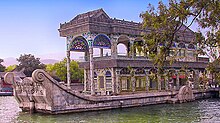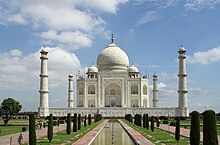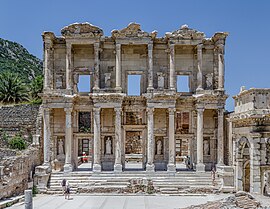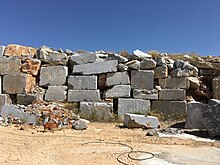Marble
Marble is a
), although there are exceptions.In geology, the term marble refers to metamorphosed limestone, but its use in stonemasonry more broadly encompasses unmetamorphosed limestone.[2] Marble is commonly used for sculpture and as a building material.
Etymology

The word "marble" derives from the
This

Geology

Marble is a rock resulting from metamorphism of sedimentary carbonate rocks, most commonly limestone or dolomite. Metamorphism causes variable recrystallization of the original carbonate mineral grains. The resulting marble rock is typically composed of an interlocking mosaic of carbonate crystals. Primary sedimentary textures and structures of the original carbonate rock (protolith) have typically been modified or destroyed.
Pure white marble is the result of metamorphism of a very pure (
Chemistry
Degradation by acids
Acids react with the calcium carbonate in marble, producing carbonic acid (which decomposes quickly to CO2 and H2O) and other soluble salts :[10]
- CaCO3(s) + 2H+(aq) → Ca2+(aq) + CO2(g) + H2O (l)
Outdoor marble statues, gravestones, or other marble structures are damaged by acid rain whether by carbonation, sulfation or the formation of "black-crust" (accumulation of calcium sulphate, nitrates and carbon particles).[10] Vinegar and other acidic solutions should be avoided in the cleaning of marble products.
Crystallization
Crystallization refers to a method of imparting a glossy, more durable finish on to a marble floor (CaCO3). It involves polishing the surface with an acidic solution and a steel wool pad on a flooring machine. The chemical reaction below shows a typical process using magnesium fluorosilicate (MgSiF6) and hydrochloric acid (HCl) taking place.
- CaCO3(s) + MgSiF6(l) + 2HCl (l) → MgCl2(s) + CaSiF6(s) + CO2(g) + H2O(l)
The resulting calcium hexafluorosilicate (CaSiF6) is bonded to the surface of the marble. This is harder, more glossy and stain resistant compared to the original surface.
The other often used method of finishing marble is to polish with oxalic acid (H2C2O4), an organic acid. The resulting reaction is as follows:
- CaCO3(s) + H2C2O4(l) → CaC2O4(s) + CO2(g) + H2O(l)
In this case the calcium oxalate (CaC2O4) formed in the reaction is washed away with the slurry, leaving a surface that has not been chemically changed.[11]
Microbial degradation
The haloalkaliphilic methylotrophic bacterium
Types and features



Examples of notable marble varieties and locations
Features
Marble is a rock composed of calcium and magnesium carbonate, mostly white and pink.[1] Common marble varieties are granular limestone or dolomite. The hardness of marble is very high, because the internal structure of the rock is very uniform after long-term natural aging, and the internal stress disappears, so the marble will not be deformed due to temperature, and has strong wear resistance. It is a very popular building material.
The following table is a summary of the features of Marble.[17]
| Colour | White, Pink, Black etc |
|---|---|
| Texture | granular |
| Grain size | medium grained |
| Mineralogy | calcite |
| Hardness | hard |
| Other features | generally gritty to touch |
| Uses | building stone |
Uses

Sculpture
White marble has been prized for its use in sculptures[18] since classical times. This preference has to do with its softness, which made it easier to carve, relative isotropy and homogeneity, and a relative resistance to shattering. Also, the low index of refraction of calcite allows light to penetrate 12.7 to 38 millimeters into the stone before being scattered out, resulting in the characteristic waxy look which brings a lifelike luster to marble sculptures of any kind, which is why many sculptors preferred and still prefer marble for sculpting the human form.[19]
Construction
Construction marble is a stone which is composed of calcite, dolomite or serpentine that is capable of taking a polish.[20] More generally in construction, specifically the dimension stone trade, the term marble is used for any crystalline calcitic rock (and some non-calcitic rocks) useful as building stone. For example, Tennessee marble is really a dense granular fossiliferous gray to pink to maroon Ordovician limestone, that geologists call the Holston Formation.
Production

The extraction of marble is performed by quarrying. Blocks are favoured for most purposes, and can be created through various techniques, including drilling and blasting, water jet and wedge methods.[22] Limestones are often commercially and historically referred to as marble, which differs from the geological definition.
Locations
In 1998, marble production was dominated by 4 countries that accounted for almost half of world production of marble and decorative stone. Italy and China were the world leaders, each representing 16% of world production, while Spain and India produced 9% and 8%, respectively.[23]
In 2018 Turkey was the world leader in marble export, with 42% share in global marble trade, followed by Italy with 18% and Greece with 10%. The largest importer of marble in 2018 was China with a 64% market share, followed by India with 11% and Italy with 5%.[24]
Ancient times
White marbles throughout the
United States
According to the United States Geological Survey, U.S. domestic marble production in 2006 was 46,400 tons valued at about $18.1 million, compared to 72,300 tons valued at $18.9 million in 2005. Crushed marble production (for aggregate and industrial uses) in 2006 was 11.8 million tons valued at $116 million, of which 6.5 million tons was finely ground calcium carbonate and the rest was construction aggregate. For comparison, 2005 crushed marble production was 7.76 million tons valued at $58.7 million, of which 4.8 million tons was finely ground calcium carbonate and the rest was construction aggregate. U.S. dimension marble demand is about 1.3 million tons. The DSAN World Demand for (finished) Marble Index has shown a growth of 12% annually for the 2000–2006 period, compared to 10.5% annually for the 2000–2005 period. The largest dimension marble application is tile.
Palestine
The stone and marble industry is one of the largest industries in Palestine, contributing 20-25% of its total industrial revenues, generating USD $400–$450 million in revenue annually. The industry employs 15,000–20,000 workers across the West Bank across 1200–1700 facilities, and amounts to 4.5% of the nation's GDP. The vast majority of the industry's exports are to Israel.
Marble in the geologic sense does not naturally outcrop in Palestine, and that the vast majority of commercially labeled marble produced in Palestine produced would be geologically considered limestone.[26]
Occupational safety
Particulate air pollution exposure has been found to be elevated in the marble production industry. Exposure to the dust produced by cutting marble could impair lung function or cause lung disease in workers, such as silicosis. Skin and eye problems are also a potential hazard. Mitigations such as dust filters, or dust suppression are suggested, but more research needs to be carried out on the efficacy of safety measures.[27][26]
In the United States, the Occupational Safety and Health Administration (OSHA) has set the legal limit (permissible exposure limit) for marble exposure in the workplace as 15 mg/m3 total exposure and 5 mg/m3 respiratory exposure over an 8-hour workday. The National Institute for Occupational Safety and Health (NIOSH) has set a recommended exposure limit (REL) of 10 mg/m3 total exposure and 5 mg/m3 respiratory exposure over an 8-hour workday.[28][non sequitur]
Dust, debris and temperature fluctuations from working marble can endanger the eye health of employees.[29] For the staff involved in marble processing, it is necessary to provide eye protection equipment, and it is recommended to improve the education of all workers on occupational health risks and strengthen preventive measures.[29]
Cultural associations

As the favorite medium for Greek and Roman sculptors and architects (see classical sculpture), marble has become a cultural symbol of tradition and refined taste. Its extremely varied and colorful patterns make it a favorite decorative material.[30]
Places named after the stone include
Impact on the environment

Total world
Sustainability
Marble[1] sludge waste can be used as a mineral filler in water-based paints.[32] Using ground calcium carbonate as a filler in paint production can improve the brightness, hiding power and application performance of paint, and can also replace expensive pigments such as titanium dioxide.[32] Recycling of marble waste leads to a large amount of waste not being landfilled, reducing environmental pollution, thereby realizing the sustainability of marble. Converting waste to generate economic income and restore degraded soil can improve the environment.
Cleaning and preservation
The nature of marble is soft and porous, so it is easily stained by colored liquids and scratches easily. Maintenance and cleaning is particularly important.[33]
Preservation
- Prevent sand and dust from contacting the marble surface.[33]
- Avoid corroding marble surfaces with alcohol, color and acidic liquids.[33]
Cleaning
- As a floor material, marble is easy to scratch. You can first use a vacuum cleaner to suck away the grit and dust on the marble floor, and then use a steam cleaner to remove other dirt.[34]
- A mild, pH-neutral, non-abrasive soap should be used for cleaning marble surfaces. Wipe with a soft foam cotton or rag.[34]
Gallery
-
The Nike of Samothrace is made of Parian marble (c. 220–190 BC)
-
Laocoön and His Sons in the Vatican
-
The Praetorians Relief, made from grey veined marble, c. 51–52 AD
-
The Metropolitan Museum of Artin New York City.
-
Näckrosen (Water Lily), Stockholm 1892, by Swedish sculptor Per Hasselberg (1850–1894). Here a copy from 1953 in marble by Giovanni Ardini (Italy) placed in Rottneros Park near Sunne in Värmland/Sweden.
-
Pažaislis Monastery complex has the most marble-decorated Baroque church of the Grand Duchy of Lithuania
-
The tombs of Emperor Pedro II of Brazil and other members of the Brazilian imperial family, made from Carrara marble in the Cathedral of Petrópolis, Brazil
-
Carlo Franzoni's life-size sculptural marbleU.S. Capitol Building).
See also
- Grand Antique marble
- Marble sculpture
- Marmorino
- Naxian marble
- Paper marbling
- Pietra dura, inlaying with marble and other stones
- Ruin marble, marble that contains light and dark patterns, giving the impression of a ruined cityscape
- Scagliola, imitating marble with plasterwork
- Verd antique, sometimes (erroneously) called "serpentine marble", and often confused with Connemara marble
References
- ^ a b c d e "Marble | Definition, Types, Uses, & Facts | Britannica". www.britannica.com. Retrieved 2023-02-10.
- ISBN 978-0-14-051494-0
- ^ μάρμαρον[permanent dead link], Henry George Liddell, Robert Scott, A Greek–English Lexicon, on Perseus Digital Library
- ^ μάρμαρος, Henry George Liddell, Robert Scott, A Greek–English Lexicon, on Perseus Digital Library
- ^ Marble, Compact Oxford English Dictionary[dead link]. Askoxford.com. Retrieved on 2011-09-30.
- ^ μαρμαίρω, Henry George Liddell, Robert Scott, A Greek–English Lexicon, on Perseus Digital Library
- ^ R. S. P. Beekes, Etymological Dictionary of Greek, Brill, 2009, p. 907.
- ^ "Definition of MARMOREAL". www.merriam-webster.com. Retrieved 2020-06-18.
- ^ "Definition of MARBLE". www.merriam-webster.com. Merriam-Webster. Retrieved 26 October 2022.
- ^ a b "Environmental degradation of marble". What is Chemistry?. University Federico II of Naples, Italy. Retrieved 5 November 2021.
- ^ "Crystallization vs. Oxalic Acid Polishing" (PDF). 3M.
- PMID 16211855.
- PMID 17658586.
- PMID 17071788.
- ^ Pentelic marble, Britannica Online Encyclopaedia. Britannica.com. Retrieved on 2011-09-30.
- ^ "RAPORT DE ȚARĂ. Domul din Milano a fost reconstruit cu marmură de Rușchița". Archived from the original on 2013-05-14. Retrieved 2013-04-18.
- ^ "Geology – rocks and minerals". rocksminerals.flexiblelearning.auckland.ac.nz. Retrieved 2023-03-24.
- ISBN 9788896680315.
white marble prized for use to make sculptures.
- ISBN 9780192800435
- ^ Marble Institute of America pp. 223 Glossary
- ^ "Turkmenistan enters record books for having the most white marble buildings | World news". theguardian.com. London. 2013-05-26. Retrieved 2013-11-24.
- S2CID 55998785.
- ^ Strategic positioning study of the marble branch Archived 2005-11-10 at the Wayback Machine. CEPI Brief N° 6. tunisianindustry.nat.tn
- ^ Comtrade. "Comtrade Explorer - Snapshot HS 2515 (Marble, travertine, ecaussine and other stone)". United Nations Commodity Trade Statistics Database. Retrieved 31 January 2020.
- S2CID 256220068.
- ^ PMID 33528771.
- ^ Foja, A.F. (1993) Marble industry: its socioeconomic, environmental and health effects among marble worker/producer households in Romblon Archived 2016-04-28 at the Wayback Machine. Philippines University Thesis. fao.org
- ^ "CDC – NIOSH Pocket Guide to Chemical Hazards – Marble". www.cdc.gov. Retrieved 2015-11-27.
- ^ PMID 35066853.
- ^ Granite, Arch City (2016-01-25). "The History of Marble Stone And Why It's so Popular For Countertops". Arch City Granite & Marble. Retrieved 2023-07-06.
- ^ "Cities named Marble. How many places are named Marble?". geotargit.com. Retrieved 2023-07-06.
- ^ S2CID 246736434.
- ^ a b c "How to Clean Marble". Better Homes & Gardens. Retrieved 2023-03-24.
- ^ a b "How to Clean Marble". This Old House. Retrieved 2023-03-24.
External links
- Dimension Stone Statistics and Information – United States Geological Survey minerals information for dimension stone
- USGS 2005 Minerals Yearbook: Stone, Crushed
- USGS 2005 Minerals Yearbook: Stone, Dimension
- USGS 2006 Minerals Yearbook: Stone, Crushed
- USGS 2006 Minerals Yearbook: Stone, Dimension
- Marble Institute of America










